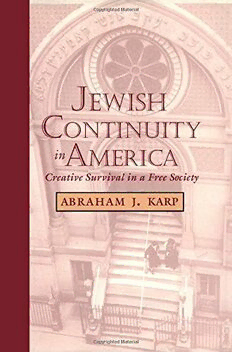
Jewish Continuity in America: Creative Survival in a Free Society PDF
Preview Jewish Continuity in America: Creative Survival in a Free Society
JEWISH CONTINUITY IN AMERICA JUDAIC STUDIES SERIES Leon J. Weinberger GENERAL EDITOR JEWISH CONTINUITY IN AMERICA Creative Survival in a Free Society ABRAHAM J. KARP THE UNIVERSITY OF ALABAMA PRESS Tuscaloosa The University of Alabama Press Tuscaloosa, Alabama 35487-0380 uapress.ua.edu Copyright © 1998 by the University of Alabama Press All rights reserved. Hardcover edition published 1998. Paperback edition published 2015. eBook edition published 2015. Inquiries about reproducing material from this work should be addressed to the University of Alabama Press. Manufactured in the United States of America Cover photograph: Synagogue, 1938 (Pitt Street Synagogue, New York, N.Y.); photo by Walter Rosenblum Cover design: Lucinda Smith ∞ The paper on which this book is printed meets the minimum requirements of American National Standard for Information Science–Permanence of Paper for Printed Library Materials, ANSI Z39.48-1984. Paperback ISBN: 978-0-8173-5822-8 eBook ISBN: 978-0-8173-8842-3 A previous edition of this book has been catalogued by the Library of Congress as follows: Library of Congress Cataloging-in-Publication Data Karp, Abraham J. Jewish continuity in America : creative survival in a free society / Abraham J. Karp. p. cm. — (Judaic studies series) Includes bibliographical references and index. ISBN 0-8173-0923-3 (cloth) 1. Judaism—United States—History. 2. Judaism—History—Modern period, 1750– 3. Rabbis—United States. 4. Conservative Judaism—United States—History. I. Title. II. Series: Judaic studies series (Unnumbered) BM205 .K38 1998 296'.0973—ddc21 98-8951 British Library Cataloguing-in-Publication data available CONTENTS Preface ix Acknowledgments xiii Introduction: Quest for a Viable Identity 1 PART ONE: THE SYNAGOGUE IN AMERICA l. The Synagogue in America: A Historical Typology 17 2. The Americanization of Congregation Beth Israel, Rochester 45 PART TWO: THE AMERICAN RABBINATE 3. Expanding the Parameters of the Rabbinate: Isaac Leeser of Philadelphia 109 4. From Campus to Pulpit: Simon Tuska of Rochester 122 5. American Rabbis for America: Solomon Schechter Comes to the Seminary 132 6. New York Chooses a Chief Rabbi: Jacob Joseph of Vilna 145 PART THREE: A PLURALISTIC RELIGIOUS COMMUNITY 7. The Tripartite Division: How It Came to Be 193 8. A Century of Conservative Judaism 204 Postscript: Between Fear and Faith 259 Notes 267 Glossary 291 Index 293 PREFACE J ewish life in North America almost came to an end before it began. No sooner had the twenty-three Jewish refugees fleeing the Portu guese reconquest of Recife, Brazil, set foot in New Amsterdam in late summer 1654 than the governor of the colony, Peter Stuyvesant, asked permission from the Dutch West India Company "to request them to depart." Fortunately, word of his request reached leaders of the Jewish community in Amsterdam, who immediately petitioned the company, arguing that such a decree would be "of no advantage to the general Com pany but rather damaging" to it, reminding the directors that "many of the Jewish nation are principal shareholders of the Company." Just a half year after the arrival, on April 26, 1655, the company instructed Stuy vesant, "The people may travel and trade to and in New Netherlands and live and remain there."l The Jews did remain, and more came in ever-increasing numbers. New Amsterdam became New York. In time New York became the city with the largest Jewish population, by far, in the long history of the Jew ish people, and the Jews of the United States became the largest Jewish community in the world. The incident in New Amsterdam was the first and last direct overt threat from without to Jewish survival in America, but threats to sur vival coming from within have been many. The ease of assimilation into America's free and open society led W. M. Rosenblatt, a perceptive ob server of the American scene, to conclude in 1872 that "within fifty years ... the grandchildren, at the latest, will be indistinguishable from the mass of humanity which surrounds them .... Of that ancient people only the history of their peril and their suffering will remain, and the change that came over them in an enlightened age. Two decades later, ,,2 Rabbi Jacob David Willowsky expressed it conditionally, "If we do not bestir ourselves now, I am sore afraid that there will be no Jews left in America in the next generation. ,,3 American Jews, like other Jews before them, have lived within a para dox of faith and fear-the faith that they are an eternal people, and the fear that their generation may be the last. The survival of every Jewish community has been conditional. The studies in this volume describe
